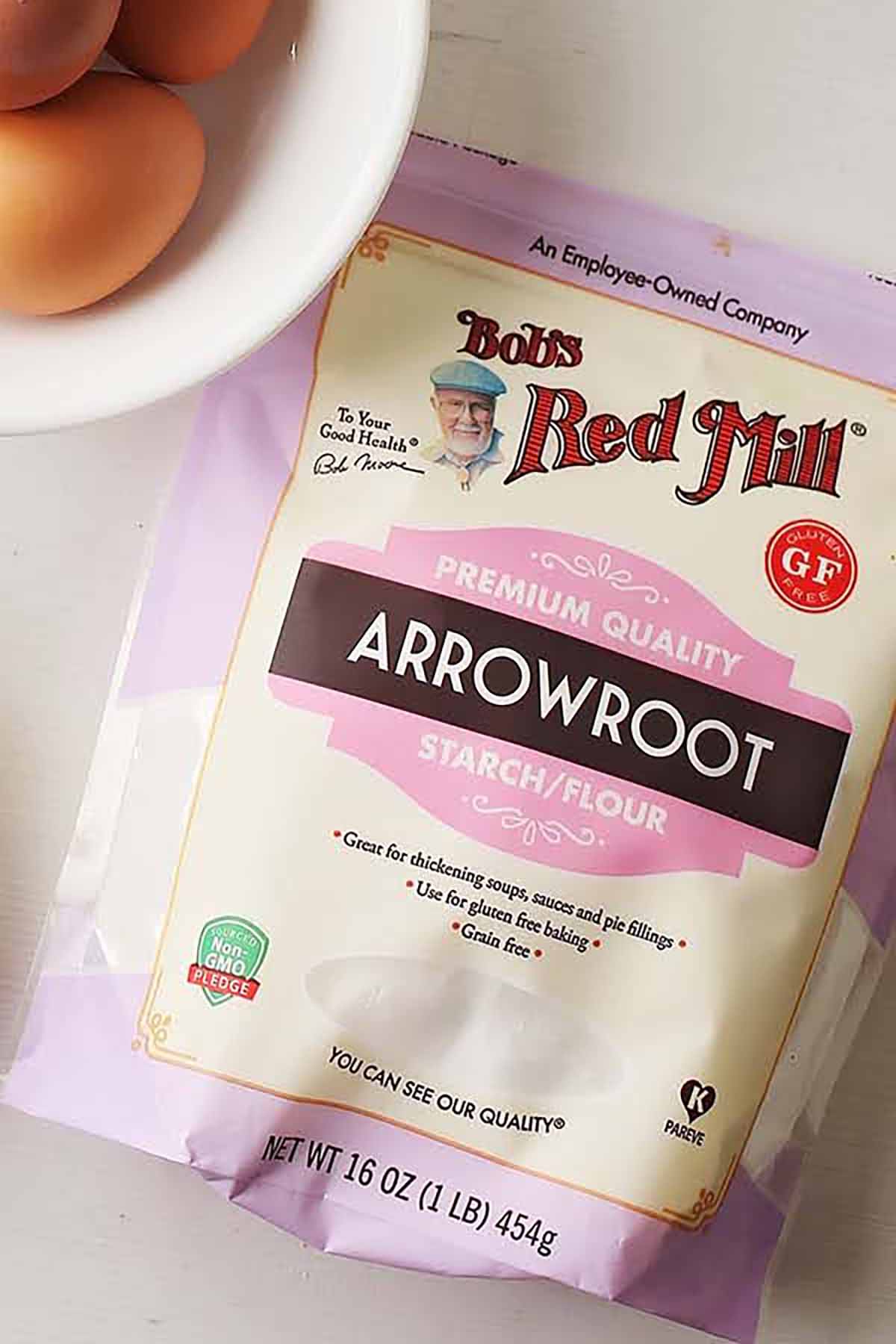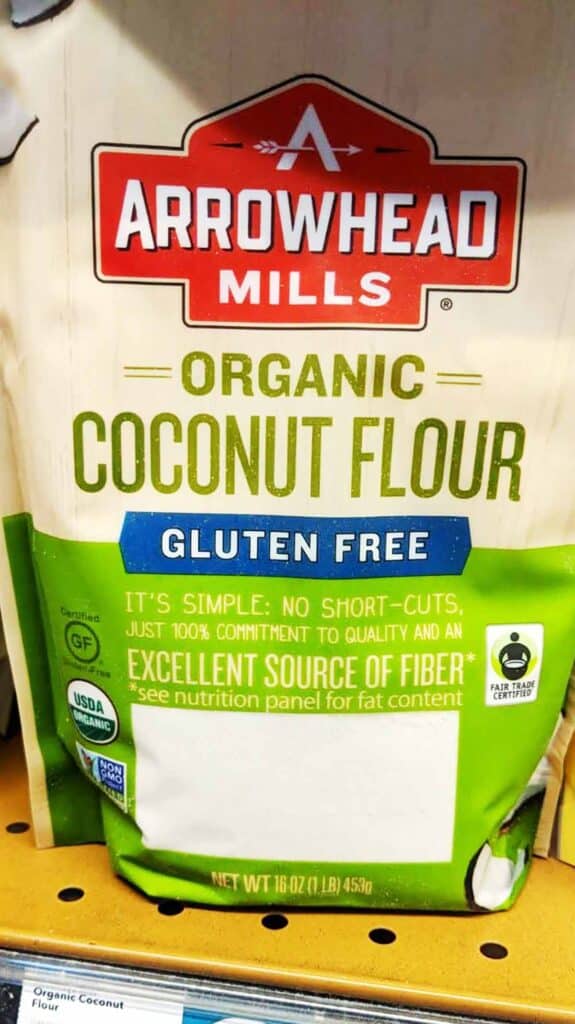This article will list the best arrowroot starch substitute options for your dish. If you don’t have any arrowroot lying around, there are many alternatives that you can try.
Arrowroot starch is known and loved as one of the best thickening agents and gluten-free flour. However, this ingredient is not the most easily accessible.

Arrowroot starch (or arrowroot flour or arrowroot powder) is a fine, white powder that comes from the rootstock of the arrowroot plant.
People extract the starch from the rootstock through an initial process of washing, peeling, and grounding. Then, a drying and sieving procedure follows to obtain a smooth, fine powder.
Arrowroot flour is popular for its unique properties, making it an excellent ingredient in cooking and baking.
It is a gluten-free alternative to wheat flour and cornstarch.
The starch is neutral in taste and smell, too. That said, it blends seamlessly into many recipes without altering the flavor of the dishes.
One of the most remarkable characteristics of arrowroot is its exceptional thickening power.
When you add it to liquids and heat the mixture, you’ll get a clear and glossy gel-like consistency. This thickening property makes arrowroot an ideal ingredient for sauces, gravies, soups, and fillings.
Arrowroot flour also contributes to a lighter and airy texture in gluten-free baking, enhancing the quality of cakes, cookies, and other baked goods.
It also helps in preventing gluten-free baked products from becoming dry and crumbly.
Arrowroot does several things to recipes. Here’s a rundown of how this ingredient affects your dishes:
As mentioned, arrowroot is a great thickening agent, especially in soups, sauces, and other liquid-based dishes.
When mixed with water and added to a hot liquid, arrowroot’s starches absorb the liquid and swell, creating a thickened consistency.
Unlike some other thickening agents, arrowroot doesn’t turn the liquid cloudy. Instead, it creates a clear and glossy finish. For this reason, it is perfect for clear sauces, fillings, and desserts.
Many cooks especially love this starch for dishes that need an aesthetically pleasing appearance.
Arrowroot retains its thickening properties even when you expose it to high temperatures for an extended period.
This property makes it suitable for baking and cooking processes requiring prolonged heating.
Whether you’re out of the thickening agent or you just want an alternative to arrowroot flour, you can use a wide variety of ingredients in its place.
Each substitute will have a distinct effect that can help elevate your dish.
Here is the list of the top 10 substitutes for arrowroot powder:

When talking about arrowroot powder substitutes, cornstarch is the number one ingredient that comes to mind.
Cornstarch is a starch made from corn grains. Home cooks use these two ingredients interchangeably, although they have distinct differences.
Both arrowroot and cornstarch are flavorless and have strong thickening properties. Like arrowroot, cornstarch also gives recipes that glossy shine.
Tips:
If it’s your first time substituting, it’s best to use half the amount of what the recipe calls for.

All-purpose flour is a go-to for thickening sauces and liquid-based dishes. For this reason, it is a great arrowroot powder substitute whose primary purpose is to thicken liquid-based dishes.
Do note that it doesn’t give off that clear and glossy texture that arrowroot powder does. The mixture will be more cloudy if you use all-purpose flour.
All-purpose flour is a widely-available ingredient. Most people have them in their household, which makes it a great option if you have no time to run out to the store.
Tips:
Use two tablespoons of all-purpose flour for every tablespoon of arrowroot powder in a recipe.

Another amazing alternative to arrowroot is tapioca starch which comes from cassava root. It is also called tapioca starch.
Like arrowroot flour, tapioca starch is also gluten-free. Tapioca starch is a flour that comes from the cassava plant. It is also neutral-tasting and vegan.
This flour is a great option for people who are careful about the ingredients in their food.
Tapioca starch is a great thickening agent for soups, stews, and gravies. It is also great for jams and pies, basically anything that needs arrowroot powder.
Keep in mind, when using tapioca flour, that it does not do well after freezing.
Tips:
When using tapioca flour, following a 1:1 ratio is ideal. Any recipe with tapioca flour will have an odd texture if you freeze and thaw it.
Xanthan gum is a food additive used as a thickener or stabilizer, which makes it a suitable replacement for arrowroot.
Although xanthan gum works well as a substitute, you should use it sparingly. Too much of it in a recipe can give a slimy texture that makes the dish less pleasing.
Most recipes that use arrowroot powder can also use xanthan gum. Xanthan gum is best for sauces, dressings, and puddings.
Tips:
For every tablespoon of arrowroot powder, use a teaspoon of xanthan gum. Build your way up from there, but remember that too much will give your recipe an odd texture.

Although not the best arrowroot substitute, potato starch is a suitable option.
These starches have many similarities, such as their neutral taste, texture, and thickening powers.
However, it’s important to note that potato starch is denser than arrowroot powder. It is also less absorbent than arrowroot, so the results might not be identical.
Tips:
You can use potato starch as you would arrowroot powder. However, this works best in recipes that require baking. Replace arrowroot powder with potato starch in a 1:1 ratio.

You might wonder what potato flakes are and how they can substitute arrowroot starch.
Potato flakes are basically mashed potatoes. People dehydrate and flatten them, though, giving them their distinct appearance.
This ingredient is a suitable swap for arrowroot powder because they’re starchy. Potato flakes help add starch content to recipes, so it works wonderfully as a thickener.
Like arrowroot, potato flakes have a neutral taste when you use only a small amount. The main difference between the two is that potato flakes are less dense than arrowroot powder.
Tips:
You can start with a 1:1 ratio. Add more potato flakes to your recipe if you want them to be as dense as arrowroot powder. Be careful of going overboard, as too much of it can give off an earthy taste.

Rice flour is a type of flour made from finely milled rice. It is another great gluten-free substitute option for arrowroot. After all, it is easily accessible.
Rice flour is suitable as a replacement for many kinds of recipes. However, it’s most effective for baked goods and desserts, especially frozen ones.
It’s important to note that rice flour will give off a cloudy appearance to the recipe. They will look far from the glossy texture of arrowroot. Additionally, rice flour has a higher starch content than arrowroot flour.
Tips:
For the best results, always use half the amount of rice flour as you would arrowroot. Then, blend it with equal amounts of water before substituting. Make sure that you monitor rice flour when added to a recipe to avoid clumping.
Wheat flour works the same way that all-purpose flour works. That said, it’s a no-brainer that you can also use it as a substitute for arrowroot starch.
The main difference with all-purpose flour is that this flour has a higher fiber and protein content.
However, wheat flour has major differences with arrowroot powder. For one, it is not gluten-free, so it’s not a good option for people with allergies or intolerances.
This flour also has a slightly nutty flavor, unlike the neutral taste of arrowroot. Remember these things if you plan to use it as a substitute.
It’s best to monitor your dish if you’re using this type of flour. The final dish can get clumpy if not cooked properly.
Tips:
For every teaspoon of arrowroot, use three teaspoons of wheat flour. Use it to thicken sauces, stews, and gravies. Adjust the amount depending on your preference.

Coconut flour, although not the best, is also an acceptable alternative. This flour comes from dried and ground coconut flesh. For this reason, it is a gluten-free option.
Additionally, it is highly absorbent, so you won’t need much of it when using it instead of arrowroot powder.
It is worth noting that coconut flour tastes mildly sweet and nutty. It may alter the taste of your recipes.
Tips:
Use only half a tablespoon of coconut flour for every tablespoon of arrowroot powder that your recipe requires.

Rich in fiber and naturally gluten-free, psyllium husk is another good substitute for arrowroot powder. It comes from milled psyllium seeds.
When added to liquids, psyllium husk forms a gel that helps recipes become thicker. Additionally, it has a neutral flavor. However, big amounts of it can lead to a subtle nutty flavor in your recipes.
Psyllium husk has a grainy texture because of its high fiber content. Your dishes won’t have the same mouthfeel but will still have a pleasant texture. Psyllium husk can also slightly discolor your baked goods.
Tips:
It’s best to use only half of what the recipe needs if you want to retain the original flavor of your dish. For instance, use only a teaspoon of psyllium husk for every two teaspoons of arrowroot powder.
No, it does not have a flavor. One of the reasons why arrowroot is a perfect thickening agent is that it is flavorless. Arrowroot doesn’t impart any distinct taste or aroma to your dishes. This neutrality allows the other flavors in the recipe to shine without interference.
Arrowroot and cornstarch are not the same. These two are distinct types of starches from different sources with specific characteristics. Arrowroot flour comes from the rootstock of the arrowroot plant. Corn starch, on the other hand, comes from corn kernels.
When used in baking, arrowroot powder mainly serves as a gluten-free binder. It helps hold the ingredients together and create structure in baked goods.
Arrowroot powder is a popular thickening and binding agent that people use in cooking and baking. Skipping it will result in a completely different dish. Luckily, you don’t have to deal with a complete culinary disaster if you don’t have it. Fortunately, there are several swaps for arrowroot powder that you can use in your recipes.
Some potential alternatives include cornstarch, all-purpose flour, wheat flour, and potato starch. Even sweet rice flour, coconut flour, and psyllium husk are possible replacements.
Each option brings something unique to the dish. However, remember that some of these options might call for recipe adjustments. Nevertheless, an arrowroot starch substitute can save the day if you need a thickener.





